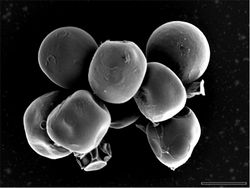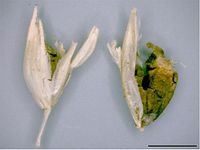Tilletia laevis
| Literature database |
|---|
| 42 articles sorted by: |
| • year (recent ones first) |
| • research topics |
| • countries/regions |
| • host plants |

Author(s): Desley Tree, DEEDI
Source: PaDIL
Tilletia laevis J.G. Kühn (1873)
This smut fungus is widely distributed in wheat-growing countries and causes common bunt. Infections affect mainly the ears, which are shorter and have kernels which are transformed into grayish-brown sori (bunt balls) that produce a fishy odour. The infected plants are often stunted with a reduced root system (e.g. Dumalasová & Bartos, 2007). The biology and morphology of T. laevis is very similar to that of Tilletia caries. Both species can be separated by their teliospore morphology.
Like in T. caries the teliospores of T. laevis disperse through the air or through infected seeds. They can survive in the soil or on seeds for 10 years or more. Moisture and a low temperature favour the spore germination. After going through a basidiospore stage in the soil, the fungus infects the wheat seedlings before they emerge from the soil. Once the ears are formed, smutted kernels develop.
| Vernacular names | |
|---|---|
| • English: | wheat smut |
| • Español: | carbón apestoso |
Synonyms:
Tilletia foetida
- Other images of Tilletia laevis (PaDIL - click to enlarge)

